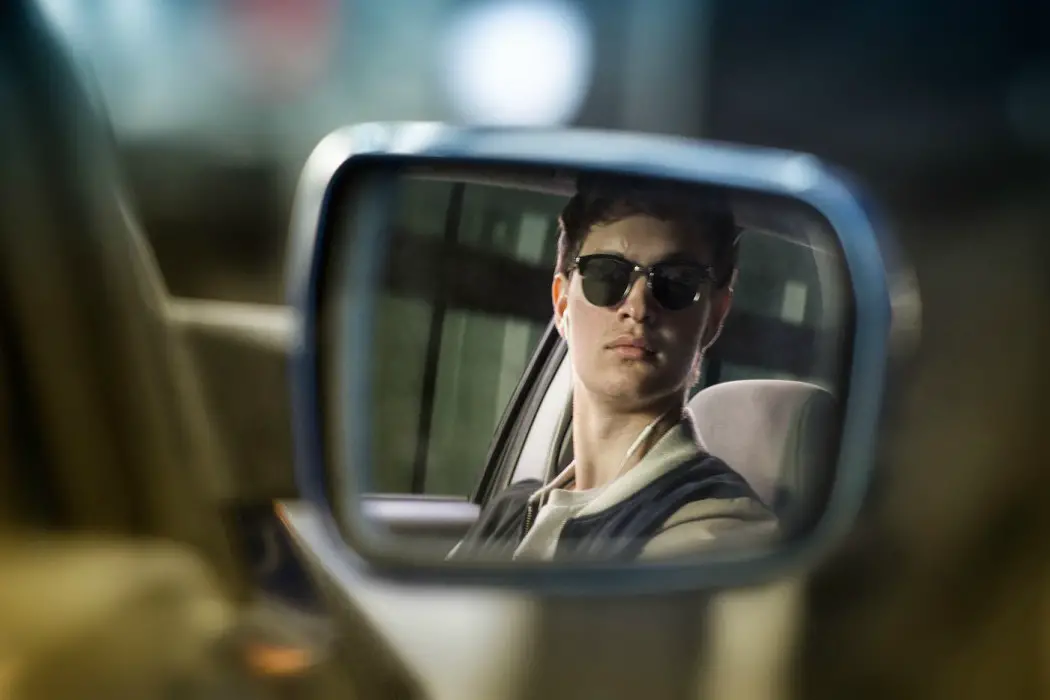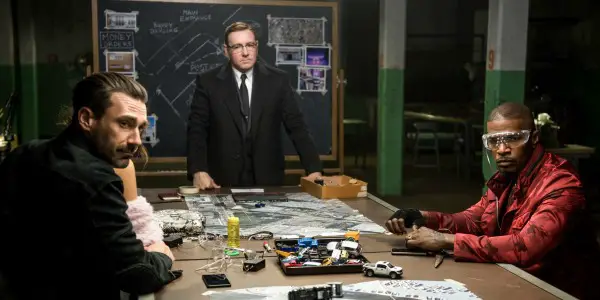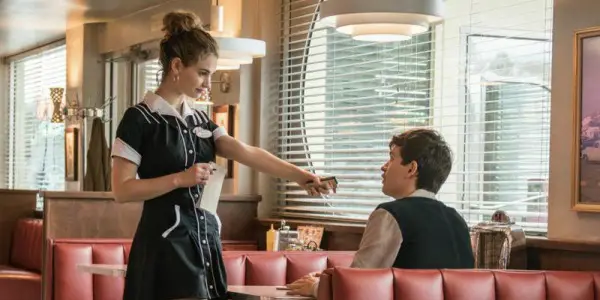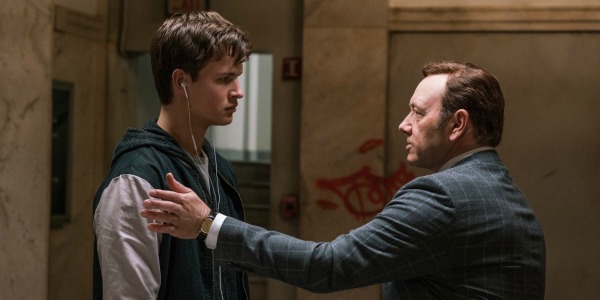BABY DRIVER: An Irresistible Pop Culture Sugar Rush

Alistair is a 25 year old writer based in Cambridge.…
In the past few years, there has been a renaissance of joyously silly, yet admirably sincere, action movies that have helped critically resurrect the genre most consistently ripe for parody. After over a decade of lazy Euro-actioners (usually helmed by Luc Besson’s Europacorp) and stale Hollywood efforts, which revel in less than coherent camerawork to obfuscate the onscreen action, it is something of a relief to see many filmmakers going out of their way to finally start shooting action sequences in artfully designed shots, where the masterful action choreography can be clearly seen and appreciated.
Pedal to the metal
Into this action resurgence steps Edgar Wright, the century’s most beloved comedic auteur, whose love for action films has no limits. After all, Hot Fuzz was an affectionate love letter to buddy cop movies and the oeuvre of director Michael Bay, while Scott Pilgrim Vs The World took inspiration from a number of classic martial arts movies in its delightfully insane fight scenes.
With his latest film, the long gestating passion project Baby Driver, he has made his most sincere film within that genre to date, taking a simple B-movie narrative (a getaway driver can’t escape the criminal underworld, even after completing “one last job”), and then transforming it into an irresistibly stylish pop culture confection, which despite taking the shape of a jukebox musical, is presented in full sincerity. Wright’s tongue isn’t lodged in his cheek – he has a sincere appreciation for practical stunts, car chases and classic pop/rock music, and it proves to be infectious from the opening moments.

Ansel Elgort stars as Baby, a getaway driver who drowns out daily life through a variety of obsessively collated IPod playlists, after a childhood car crash left him with tinnitus. When we are introduced to him, he’s driving on a series of jobs so he can be financially square with mysterious underworld boss Doc (Kevin Spacey, who has seldom been this great since the nineties).
However, despite squaring up, he is blackmailed back in to another job, driving three unpredictable robbers (Jon Hamm, Eiza Gonzalez and Jamie Foxx in “Motherf*cker Jones” mode) – threatening his blossoming relationship with diner waitress Deborah (Lily James), as well as his deaf foster father Joseph (CJ Jones), who is dependant on Baby’s stability. Unable to escape from the reality of his criminal life, he plots a dream escape with Deborah, which is threatened by the violent unpredictability of the heist he has been roped in to help out with.
A Masterclass in Design
From an aesthetic perspective, Wright has always given more attention to detail than any other comedic filmmaker working today. Here, special credit has to go to the painstaking editing work, courtesy of Jonathan Amos and Paul Machliss, which has successfully attempted to sync every song on the soundtrack up to the action unfolding on screen.
Guns fire when we hear drum beats, car doors slam when we hear a chord progression, the pedal is pushed firmly to the metal when a guitar solo kicks in – but it isn’t just the action playing out in sweet synchronicity to Baby’s record collection. Even everyday conversation, and simple gestures, wind up being synced to the sounds ringing in Baby’s headphones; the whole world unknowingly acting out a dance routine to the music he’s listening to. One recurring gag even involves Baby secretly recording conversations to edit in to quirky dance songs later, further proof of the extensive process creating the soundscape of the movie.

Although this conceit is introduced as a comedic novelty in the opening sequence, it isn’t long before Wright manages to generate palpable tension from certain tracks; the use of a Blur instrumental during a botched heist quickly gives way to the most nail biting sequence in the entire film, an unforgettable foot chase that utilises handheld camerawork in a manner reminiscent of Michael Mann. It thrillingly combines a tip of the hat to one of Wright’s most beloved filmmakers, yet with a use of music and stylish aesthetic that couldn’t be mistaken for the work of any other director.
As the common filmmaking critique goes, the trick to good editing is not realising when something has been edited – and it’s testament to the energetic joy of Wright’s film that once you’ve acclimatised to the highly choreographed opening scene, the relationship between sound and onscreen action stops being an overly apparent novelty, even though it never stops impressing.
As immediate as a great pop song
For a tiny minority of audiences, this has proved to be untrue; the style has left them so flabbergasted that the lapse in to a straightforward action narrative by the third act has left them cold. I fully disagree, because as with all of Wright’s films, beneath the referential humour and heavily designed visuals, there is always a story worth emotionally connecting with, that proves he is the master of balancing elements of style and substance – he just presents the emotion in a mannered writing style that perfectly compliments the more hyperactive stylisation elsewhere.
Here, the relationship between Baby and Debra possesses a loveable simplicity – all they want is to escape from the confines of the city, play some music and keep on driving until they leave the world behind, like a lyric in a Bruce Springsteen song. It may be easy to laugh off as cliched, but it fits the story perfectly. After all, in a film defined by its thrilling use of music, it makes perfect sense the two lead characters have a troubled romantic entanglement like those in the lyrics of the old songs they love so much. After all, pop music is known for selling complex emotions in the most simplistic manner possible – Wright has just taken that approach to screenwriting, and it fits the story perfectly.
This pop music-style immediacy extends throughout Wright’s approach to the screenplay, which is considerably different from many of his other projects. Whereas the Cornetto trilogy and Scott Pilgrim all possessed ingenious foreshadowing throughout, where every line of dialogue in the first half tended to pay off a larger gag or plot point in the second, here he takes a less complicated approach to crafting the story – although, an initially unimportant scene of Monsters Inc. playing on the TV does pay off a hilarious line from Kevin Spacey in the final act that’s practically worth the price of admission.

Of course, as with all of Wright’s films, I imagine I will be discovering new details upon every repeat view, be they in the intricate set designs or the dialogue exchanges between characters. But compared to the films that preceded it, Baby Driver is more straightforward, and just like the awesome soundtrack, races for your heart with its effective immediacy, not your head.
Although Wright has had this movie concept since the mid nineties, it is largely a feature length adaptation of a Mint Royale music video he directed back in 2003. That comedic clip, which reappears here as a blink-and-you’ll-miss-it easter egg on Baby’s TV, saw comedian Noel Fielding as the getaway driver, dancing in time to the track while the criminals he was escorting (played by Nick Frost and Julian Barratt) committed their heist while the song played. The opening sequence to Baby Driver is an extended, big budget riff on this simple concept, choreographed to within an inch of its life – and acting as the perfect introduction to this intricately designed urban fantasia.
Even though Baby Driver is one of the best recent examples of sound and vision working harmoniously, Elgort’s leading performance occasionally seems reminiscent of a silent comedy actor, in the vein of Chaplin or Keaton. Interacting with the world solely through music, in order to drown out the “hum in the drum” of his tinnitus, leaves him dancing his way through many sequences and approaching other people in the same madcap way as Chaplin’s Tramp character – something best displayed in his loving interactions with his deaf foster father, or in the utterly charming opening credits sequence. The comparisons with Drive may abound due to Elgort remaining silent for a significant portion of Baby Driver, but if anything, this just reinforces the silent movie comparison in the more joyous sequences, rather than acting as icy hipster detachment.
Conclusion
Baby Driver is far from pedestrian – in fact, it seems unlikely to be surpassed as the most joyous studio movie of the summer. In a movie landscape where major studios are refusing to work with “auteur directors”, and celebrated filmmakers can be fired from tentpole movie gigs for making something too distinctive, a tirelessly unique mainstream filmmaker like Wright needs to be celebrated, and a film like Baby Driver deserves to race to the top of the box office. He’d likely object to the term, but he is a true auteur, and this indelible cinematic sugar rush is further proof that he is the true saviour of popcorn cinema – if only multiplex audiences would wake up to this fact sooner.
Which films offer the perfect marriage between music and images? Tell us in the comments below!
Baby Driver is released in UK and US cinemas on June 28. For all international release dates, see here.
Does content like this matter to you?
Become a Member and support film journalism. Unlock access to all of Film Inquiry`s great articles. Join a community of like-minded readers who are passionate about cinema - get access to our private members Network, give back to independent filmmakers, and more.
Alistair is a 25 year old writer based in Cambridge. He has been writing about film since the start of 2014, and in addition to Film Inquiry, regularly contributes to Gay Essential and The Digital Fix, with additional bylines in Film Stories, the BFI and Vague Visages. Because of his work for Film Inquiry, he is a recognised member of GALECA, the Gay & Lesbian Entertainment Critics' Association.













